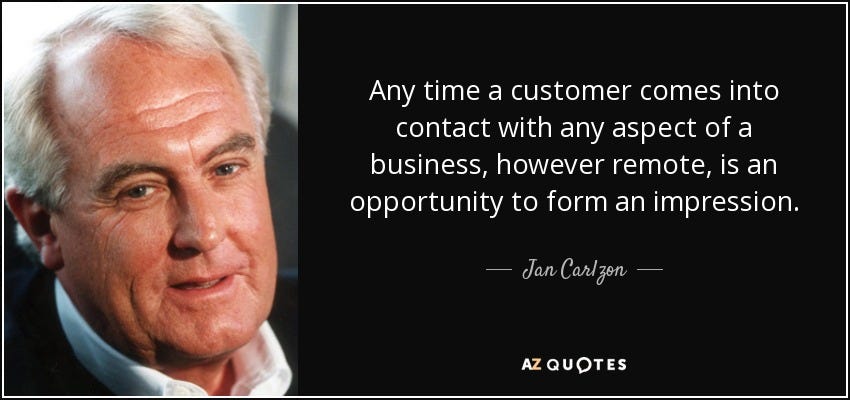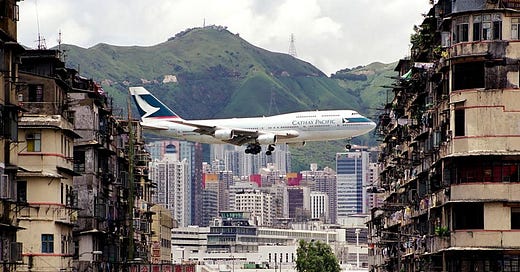How to Travel Business Class for Free
My ticket to sitting in the seats where you can't see the wings
In early March 1990, a tragic fire at the Sheraton Hotel in Cairo, Egypt claimed the lives of 17 people. The crew of a Scandinavian Airlines flight to Copenhagen were staying at the hotel and evacuated during the disaster.
They all survived, but all were shaken and traumatized. They couldn’t work the flight to Copenhagen and it had to be cancelled.
In addition to following up with their personnel, the airline had to rebook and reroute over 100 passengers. The aircraft that was stranded in Egypt was also due to fly other routes. The ripples of the impact the event caused affected many people and cost the airline millions.
One of the crew members wrote a letter in the internal SAS staff magazine calling for better checks of the hotels crews stayed in.
My father always said that if you want to get a message across to a big company, aim for the top and let it filter down from there to the right person. If you don’t aim high enough, your message may never reach the person with the authority to make a decision.
After experiencing challenges with the sales rep from one of his store’s suppliers, Dad once had stayed on the line for hours, patiently waiting to speak to the CEO of an iconic Canadian company. When he finally got through, the man listened and was genuinely grateful for my father’s persistence.
“People in the company always protect me from this kind of thing. I’m glad you insisted on speaking with me. Now hand the phone to the sales rep and I will inform him that he no longer works for us!”
When I read the article about the fire in Cairo, I remembered the story Dad had told me.
I sat down and wrote a letter to the legendary Jan Carlzon, who was CEO of the airline.
“SAS has hotels with competent security people”, I wrote, “why can’t we help you find better, safer hotels for our crew colleagues?”
If a company has a caring leader, the strategy works.
Jan Carlzon cared and it wasn’t long before I received a call from the crew management office and, not long thereafter a new checklist for crew hotel approvals was in place. While previous checklists focused on pillow quality, the number of channels on the television and whether the crew could get discounts in restaurants, bars and shopping outlets, the one I developed for them focused on safety and security in addition to checking off the comfort factors the contracts with crew unions demanded.
Jan Carlzon was a caring leader and wrote me a personal thank-you note.

From there, things took off, but not quite literally. I’ll get to that in a minute.
When there was a discussion between the union and management on whether a hotel met minimum requirements, checklists were forwarded to me for an independent decision.
In addition to designing a checklist for them, union leaders and crew management staff were invited to come to the hotel where I worked. I walked them through what we looked at when we were doing our own preventive safety and security rounds and what they might want to look at or for when they were out evaluating hotels.
It was all pro-bono of course, something which helped me build a good and trusted relationship with both parties.
One day, I received a checklist from a hotel in Hong Kong. It was a little surprising because the hotel had been used for crew layovers for some time and it was a popular place.
Management wanted to save costs by moving the crew from the executive floors to standard hotel rooms in the hotel. The crew rejected the move for “security reasons”, which was the only refusal option they had if basic location and amenity needs were met.
The building had the same lock system, fire alarm system, and the same safety, security, and staff training protocols in place throughout the building. The only minor difference was that you needed a key to operate the elevators to access the executive floors.
I wasn’t being paid for my support to the airline and thus had nothing to lose, so I took a chance.
I informed the crew management office that, looking at the checklist alone, the hotel seemed to meet the requirements, but that without seeing it with my own eyes, I didn’t want to guarantee anything.
“I’d be happy to go to Hong Kong and have a look if you feel that could help.”
In these pre-email days, I faxed them my notes and anxiously waited for the fax machine to start whirring with whatever the answer might be.
“What a great Idea! We should have thought of that long ago! When you go to Hong Kong, would you mind stopping off in Bangkok for a couple of days on your way back?”
A few weeks later, when it fit the break between night and day shift in my schedule, I was on a flight to Hong Kong. (I’ll tell you about Bangkok next week…)
Not only that, I was at the front of the bus, which wasn’t a bus but a brand new Boeing 767.
The Business Class seats were huge! There were mechanical levers here and mechanical levers there that could be used to adjust the legrest, the recliner, the armrests, and the headrest. There was even a lever to pop the table out from wherever it was hidden. I boarded the plane in Copenhagen, but I think we were somewhere over Siberia before I figured out what all the levers did.
Today, Business Class seats can become comfy, lie-flat beds in pods with 18” touch screens that can access live feeds from your favourite media outlet… it wasn’t quite like that in the early ‘90s. Still, it was mind-blowing for a hotel security guard on his week off to sit up front, pushing and pulling all the levers in the big seat!
It was an overnight flight, but I didn’t sleep much before we touched down at the legendary Kai Tak airport where, as one flight captain told me,:
“You fly down between the skyscrapers aiming for one in particular and when you get close enough to read the labels on the Lee family underwear that is hanging to dry on the balcony, you hang a hard right and there’s the runway.”
The hotel passed the test and the company probably saved some money. I’m confident most crew members weren’t too disappointed. After all, how much could they enjoy the Executive Lounge and still meet sobriety requirements for the next day’s flight?
That first flight in Business Class helped lay the foundation for my motto: “Communicate, Collaborate, Contribute”.
Wherever you work, use your knowledge, skills, and abilities to make bold suggestions.
Be persistent. Follow up and work together with others to develop your ideas into sensible solutions and then contribute whatever and however you can to see them through.
Stay safe, Always Care
Thanks for reading our newsletter!
If you’re in hospitality, read our book, Spin the Bottle Service. A local server told us it should be required reading for everyone who works in a restaurant or hotel.
If you’re an owner or manager of a business that takes pride in customer service, let’s chat about how Ditch the Script workshops can make jobs more meaningful and guest experiences more memorable by unleashing the power of the biggest business differentiator you have available - your people!
For more articles like this, click the 87 Stories tab, where we share lessons learned at the University of Life.
Thanks for being part of the Always Care Community!




